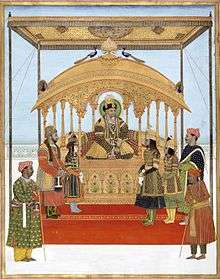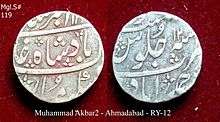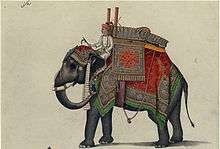Akbar II
| Akbar II | |||||
|---|---|---|---|---|---|
| Mughal Emperor | |||||
 | |||||
| 18th Mughal Emperor | |||||
| Reign | 19 November 1806 – 28 September 1837 | ||||
| Coronation | 19 November 1806 at Red Fort, Delhi | ||||
| Predecessor | Shah Alam II | ||||
| Successor | Bahadur Shah II | ||||
| Born |
22 April 1760 Mukundpur, Mughal Empire | ||||
| Died |
28 September 1837 (aged 77) Delhi, Mughal Empire | ||||
| Burial | Mehrauli, Delhi | ||||
| Issue |
14 sons including Bahadur Shah II Mirza Jahangir shah Mirza Jahan Shah Mirza Babur Mirza Salim Shah Mirza Nazim Shah Mirza Jahan Kusroo 8 daughters | ||||
| |||||
| Dynasty | Timurid | ||||
| Father | Shah Alam II | ||||
| Mother | Qudsia Begum (3rd wife of Shah Alam II) | ||||
| Religion | Islam | ||||
Akbar II (22 April 1760 – 28 September 1837), also known as Akbar Shah II, was the penultimate Mughal emperor of India. He reigned from 1806 to 1837. He was the second son of Shah Alam II and the father of Bahadur Shah II.
Akbar had little de facto power due to the increasing British influence of India through the East India Company.He sent Ram Mohan Roy as an ambassador to Britain and gave him the title of Raja. During his regime, in 1835, the East India Company (EIC) discontinued calling itself subject of the Mughal Emperor and issuing coins in his name. The Persian lines in the Company's coins to this effect were deleted.
He is credited to start the Hindu-Muslim unity festival Phool Walon Ki Sair[1]
His grave lies next to the dargah of 13th century Sufi saint Qutbuddin Bakhtiar Kaki at Mehrauli.
Early life

%2C_the_blind_mughal_Emperor%2C_seated_on_a_golden_throne..jpg)
Prince Mirza Akbar was born on 22 April 1760 to Emperor Shah Alam II at Mukundpur, Satna, while his father was in exile. On 2 May 1781, at the Red Fort, the prince was made Crown Prince with the title of Wali Ahd Bahadur, after the death of his elder brother. In In 1782 he was appointed the viceroy of Assam until 1799. When the renegade eunuch Ghulam Qadir captured Delhi, the young Prince Mirza Akbar was forced to nautch dance together along with other Mughal princes and princesses. He witnessed how the members of the imperial Mughal family were humiliated, as well as starved. When Mahmud Shah fled, Mirza Akbar was titular Emperor with the title of Akbar Shah II, and was to remain acting emperor even after the reinstation of his father Shah Alam II, till December 1788.
Reign

Emperor Akbar II presided over an empire titularly large but in effect limited to the Red Fort in Delhi alone. The cultural life of Delhi as a whole flourished during his reign. However, his attitude towards East India Company officials, especially Lord Hastings, to whom he refused to grant an audience on terms other than those of subject and sovereign, although honourable to him, increasingly frustrated the British, who regarded him as merely their pensioner. The British therefore reduced his titular authority to 'King of Delhi' in 1835 and the East India Company ceased to act as the mere lieutenants of the Mughal Empire as they did from 1803 to 1835. Simultaneously they replaced Persian text with English text on the company's coins, which no longer carried the emperor's name.
The British encouraged the Nawab of Oudh and the Nizam of Hyderabad to take royal titles in order to further diminish the Emperor's status and influence. Out of deference, the Nizam did not, but the Nawab of Awadh did so. However, Akbar II's prestige was honoured in Sindh, particularly when the Mughal Emperor issued a Firman in the year 1783, which designated Mir Fateh Ali Khan Talpur as the new Nawab of Sindh, and mediated peace particularly after ferocious fighting and the defeat of the ruling Kalhora by the Talpur tribes.[2]
Akbar II appointed the Bengali reformer Ram Mohan Roy, to appeal against his treatment by the East India Company, Ram Mohan Roy then visited England, as the Mughal envoy to the Court of St. James, conferring on him the title of Raja. Ram Mohan Roy submitted a well argued memorial on behalf of the Mughal ruler, but to no avail.
His grave lies, next to the dargah of the 13th century, Sufi saint, Qutbuddin Bakhtiar Kaki at Mehrauli, Delhi in a marble enclosure, along with that of Bahadur Shah I (Shah Alam I) and Shah Alam II.
Sair-e-Gulfaroshan
It was year 1812. East India Company had penetrated to Mughal court completely and a Resident Officer was living inside the Red Fort, controlling the administration of India. Coins were struck by British Mints and name of Mughal Emperor was removed from currency. Emperor Shah Alam II had died, for whom people started saying at the end of his reign ‘Badshah Shah Alam, Az Delhi, Ta Palam’ which means, Emperor Shah Alam’s rule is from Delhi (Red Fort) to Palam (present day Delhi Airport) only. Shah Alam II’s son, Akbar II was the puppet king and Archibald Seton, a Scottish East India Company Administrator was the appointed Officer in Red Fort. Next in line to throne, Crown Prince Mirza Jahangir was against British way of working. One day, this reckless young prince of 19 insulted Seton by calling him Lullu. Seton did not react then. Perhaps he did not understood the meaning of the word. Few days later, when Seton was returning from court, Mirza Jahangir, sitting on the roof of Naubat Khana, fired a shot at him, missing Seton completely. While Seton escaped unhurt, his orderly lost his life. Angry with this, British arrested Mirza Jahangir and sent him to Allahabad fort. Back then, it was famous that a political prisoner, who is sent to Allahabad Fort, never returns alive.
The Mughal court tried its best to save him, but the administration was in British hands completely. Having failed at every door, Empress Mumtaz Mahal, mother of Mirza Jahangir came to the shrine of Sufi Saint Khwaja Qutubuddin Bakhtiyar Kaki (ra) in Mehrauli, Delhi. She took a vow that if Mirza Jahangir returns safely, she would offer a sheet (chadar) of flowers at the Dargah.
After few years of praying, Mirza Jahangir one day miraculously returned to the Red Fort. The Empress approached Emperor Akbar II and told him about her vow. Emperor was more than happy to be a part of pledge. They both decided to start from the Red Fort with sheet of flowers for the Shrine. News spread like jungle fire and everyone in and around the Palace got ready to walk with the royal family, to pay homage to Sufi Saint resting in Mehrauli.
It was the month of September. Convoy started with all the praise singing and merry making. When they reached the outskirts of Mehrauli, Mughal Emperor stood by the Temple of Ma Yogmaya and said, Mehrauli is known for this deity and it will be a sin to pay respect to Sufi Shrine and not visit the Hindu Temple.[3]
Yogmaya Temple in Mehrauli is considered to be one of the Temples Pandavas built. It is attributed to Maa Yogmaya, sister of Lord Krishna, who was replaced with Krishna upon birth to save him from his evil uncle Kans.
Emperor Akbar II entered the Hindu Temple and offered a Pankha (fan) to the deity. He then went to the Muslim Shrine to fulfil rituals of offering Chadar. For seven days, entire court was shifted to Mehrauli and with all the merry making and celebrations, people were very happy. Emperor ordered to repeat this event every year. A palace, called Rang Mahal was constructed as every year, entire Mughal court used to get shifted to Mehrauli for 7 days. Every year, Mughal Emperor would come with everyone from Red Fort and around, with a sheet of Flowers and a decorated Fan for Temple. This festival became popular with name ‘Phoolwalon ki Sair’ or ‘Sair-i-Gul-Faroshan’.
Rang Mahal was later termed as Lal Mahal. Mirza Jahangir could never become king. Instead, his brother, who was a poet and had no interest in ruling the country, Mirza Sirajuddin aka Badshah Bahadur Shah ‘Zafar’ was made emperor. Zafar added portion to this palace and it is today popular with name Zafar Mahal.
Emperor Akbar II and his family got buried in this Zafar Mahal, next to the shrine. Emperor Zafar also designated a place for his grave next to his father, but since he was exiled to Rangoon, he could never return and fulfil his last wish.
In the early 1940s, British imposed ban on all activities that exhibited communal harmony. So was the fate of Phoolwalon ki Sair. It was stopped for almost 2 decades, until in 1961, Pt. Jawaharlal Nehru asked the mayor of Delhi, Mr. Nooruddin Ahmed and a scion of prominent family Shri Yogeshwar Dayal to revive the festival. On September 6, 1962, Pt. Nehru played the part of the Mughal Emperor and the festival was celebrated like old days. He continued to do so until his death, after which, his daughter Indira Gandhi took special interest in the festival. She invited other states of India to participate, so that the festival of Communal Harmony becomes the festival of National Communal Harmony.[4][5]
Phoolwalon ki Sair is celebrated till date, for 7 days, every September.[6] It is managed by Anjuman-i-Sair-e-Gulfaroshan, a society governed by notable Hindus and Muslims of Mehrauli. Pankha and Chadar are offered by President, Prime Minister, Chief Minister of Delhi, Lt. Governor of Delhi and different state governments.[7]
-

Akbar II holding audience on the Peacock Throne.
-

Silver Rupee coin of Akbar II.
-

Akbar Shah II rides an elephant in a huge procession 1835.
-

Mahout carrying bows and pistols.
-

Mughal parade
Descendants
After the mutiny, cousins of Mirza Mughal, son of Bahadur Shah Zafar, son of Akbar II, escaped to neighbouring areas in fear of capture by the British. Prince Mirza Mughal, the heir apparent was himself killed in battle. Many princes settled in various provinces of India, but some settled in Burma and Bengal since a large number of imperial family members, along with Emperor Bahadur Shah II were exiled to Rangoon in Burma.
See also
References
- ↑ https://vikramjits.wordpress.com/?s=Phool+walon+ki+sair
- ↑ Qammaruddin Bohra, City of Hyderabad Sindh 712–1947 (2000).
- ↑ http://www.phoolwaalonkisair.com/
- ↑ http://www.festivalsofindia.in/phoolkwalon-ki-Sair/
- ↑ http://www.thehindu.com/news/cities/Delhi/phool-walon-ki-sair-festival-begins/article7885751.ece
- ↑ http://www.phoolwaalonkisair.com/
- ↑ https://vikramjits.wordpress.com/?s=Phool+walon+ki+sair
- The New Cambridge History of India.
- Akbar Shah's Rule: Coins Of India.
External links
![]() Media related to Akbar II at Wikimedia Commons
Media related to Akbar II at Wikimedia Commons
- The Eighth Section of the Series on the Mutiny in Delhi – by Khwaja Hasan Nizami
- THE LATER MUGHALS (1707–1858)
| Akbar II Born: 1760 Died: 1837 | ||
| Regnal titles | ||
|---|---|---|
| Preceded by Shah Alam II |
Mughal Emperor 1806–1837 |
Succeeded by Bahadur Shah II |